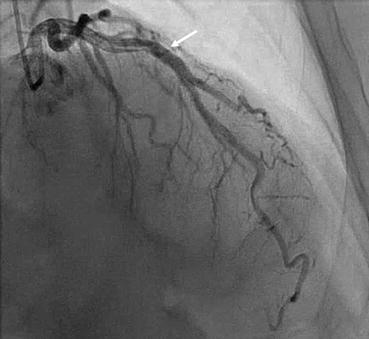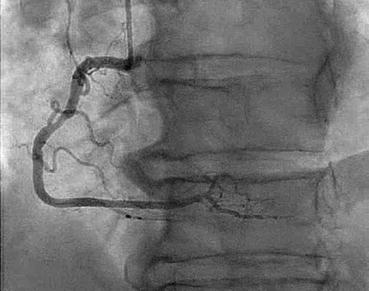Fig. 71.1 Coronary angiogram of the left coronary artery with caudal angulation showing the left anterior descending artery and the left circumflex coronary artery (arrow)

Fig. 71.2 Coronary angiogram of the left coronary artery with cranial angulation showing the left anterior descending artery (arrow) and the left circumflex coronary artery

Fig. 71.3 Coronary angiogram of the right coronary artery
Questions
- 1.
- 2.
Describe the normal coronary anatomy.
- 3.
List some indications and contraindications for cardiac catheterization.
- 4.
What are the complications of cardiac catheterization?
- 5.
What are the determinants of myocardial demand and supply?
- 6.
What defines a significant stenosis?
- 7.
What are the main components of a “cath report”?
Answers
- 1.
The images represent coronary angiography in different angiographic angulations. Coronary angiography is defined as the radiographic visualization of the coronary arteries after the injection of radiopaque iodinated contrast media [1]. This procedure is typically performed as a part of the cardiac catheterization procedure which may also include hemodynamic assessment or imaging of other cardiac chambers (usually the left ventricle). Coronary angiography is performed of both the left and right coronary arteries and bypass grafts, if present, using specialized catheters. Images are obtained in different angulations to accurately delineate the coronary anatomy. Figures 71.1 and 71.2 delineate the anatomy of the left coronary system. Figure 71.1 is a caudal angulation and best shows the left circumflex artery and its branches (arrow). Figure 71.2 is a cranial angulation view, and it best shows the left anterior descending artery and its branches (arrow). Figure 71.3 shows the right coronary artery.
Table 71.1
The main branches of the coronary arteries (in a right dominant system)
1. Left main coronary artery |
(a) Left anterior descending artery • Diagonal arteries • Septal perforator arteries |
(b) Left circumflex artery • Obtuse marginal artery • Left posterolateral artery • Left posterior descending arterya |
(c) Ramus intermedius arteryb |
2. Right coronary artery |
(a) Sinus node arteryc (b) Conus arteryd (c) Acute marginal arteries (d) Posterior descending arterye (e) Posterolateral arteries |
- 2.
There are two major epicardial arteries: the left main and the right coronary arteries originating typically from the left and right sinuses of Valsalva at the base of the ascending aorta [2]. The left main coronary artery further divides to the left anterior descending (LAD) and the left circumflex (LCX) coronary arteries. In some instances, the left main coronary artery also gives a third branch termed the ramus intermedius artery. The LAD and LCX further subdivide to diagonal and obtuse marginal arteries. The dominance of the coronary circulation is determined based on the origin of the posterior descending artery (PDA) which supplies the posterior part of the interventricular septum. The PDA arises from the right coronary artery in 70% of the patients rendering the circulation right dominant and from the left circumflex artery in 15% of the cases which makes the circulation left dominant. In the remainder of the cases, the PDA arises from both the right coronary and the left circumflex arteries, in which cases the circulation is termed codominant [3].
The nomenclature of the different segments of the coronary artery tree has been described by the Bypass Angioplasty Revascularization Investigation (BARI) group, and detailed description is beyond the scope of this chapter [4]. Table 71.1 summarizes the main branches of the coronary arteries.
Full access? Get Clinical Tree




